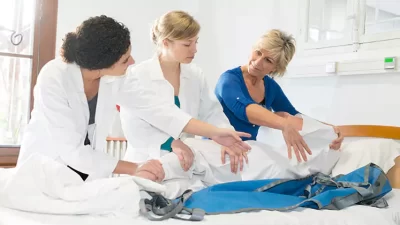Playing sports is one of the things you can do to stay active and maintain a healthy lifestyle. However, it’s essential to know that any kind of sport has risks that may lead to injuries.
These injuries are not just caused because you came in contact with another person, it can also be due to improper use of equipment, poor training, lack of conditioning, or failing to do proper warmup and cooldowns.
Most sports injuries can be prevented. But if you find yourself limping or having a hard time bending your elbows, you need to know how to address your injuries. This could assist you in avoiding further pain and frustration.
To help you overcome these accidents, here are some steps you can follow to manage sports-related joint pain.
1. Go To Physical Therapy
Physical therapy can be very beneficial for patients suffering from joint pain. Thus, it’s essential to see a health provider that is near your home for the sake of convenience. For example, if you’re in the Pacific Northwest region, you may want to look for therapists like the Orthopedic Specialists of Idaho and other agencies. This is so you don’t have to add more stress to your condition.
Seeing a physical therapist can help you manage your injured joints by:
- Improving muscle strength: Your joints don’t exist in a vacuum. Muscles surround your joints and any weakness in these muscles will put added stress on your joints. The last thing you want to do when recovering from an injury is to feel additional pain from basic movements due to weak muscles.
- Help improve your range of motion: Another advantage of working with a Physical Therapist (PT) is improving your range of motion. PTs will guide you and physically support you while doing exercises that bring back your normal range of motion.
- Can target the source of joint pain: The most obvious benefit of working with a licensed PT is getting insights into what triggers your pain, what lifestyle adjustments you must make to decrease the level of your discomfort. Working with a professional will eliminate second-guessing what causes painful scenarios.
- Physical therapists and Specialized treatments: The last thing PTs can do to help you manage your joint injury is to perform alternative types of therapy such as chiropractic care, hod and cold therapy, and therapeutic massage. All of which are incredibly helpful in alleviating your pain and discomfort.
2. Immobilize Injured Area
At the first sign of injury, it’s best to immobilize the injured area. Restricting the movement of an injured body part allows healing, reduces swelling, and prevents muscle spasms. Limiting the movement means avoiding the usual physical activities you do. These include acts such as exercising or even walking.
Sometimes, doctors or health providers recommend using casts or splints to protect the bones, tendons, or ligaments that need healing. Immobilizing also ensures the proper alignment of bones and muscles during the healing process. To help the progression of the healing process, you may also elevate the injured body part to prevent further swelling.
3. Protect Affected Area
Another step an injured person must do is to protect the affected area from further harm. They may do this by using devices that support movements like crutches for walking and arm slings or casts for other areas of the body.
4. Apply Heat Or Cold Packs
If there is swelling around the injured area, go for a cold pack. Once you feel the swelling go down, that’s when you use a hot pack.
5. Apply Correct Compression
Another way to manage your joint injury is to use compression. Compression reduces pain and swelling by putting a lot of pressure on the affected area. Swelling is the body’s response to help protect the injured part by pumping fresh cells to it. However, this is counterproductive to the healing process. A word of caution, improper use of bandages or other devices for compression may further harm the affected body part. You must put on bandages the correct way.
Although when correctly done, it could improve blood circulation by putting pressure on the injured body part. Thus, this helps prevent the buildup of lymph fluids. Adding pressure also helps get nutrient-rich blood and oxygen to the cells in the affected area to improve the healing process.
6. Use Anti-Inflammatory Medicine
Nonsteroidal Anti-Inflammatory drugs (NSAIDs) are usually prescribed to hasten the healing process of injuries. However, the use of NSAIDs in managing sports-related joint pain shouldn’t be used for the long term. Consult your doctor or health provider to know how many days can you use medication for pain management.
7. Checkout Topical Creams Or Analgesics
Counterirritants are usually topical creams or rubs you use to create a cooling or burning sensation on your skin which distracts you from pain. These types of topical solutions generally contain methyl salicylate, camphor, and menthol.
Topical NSAIDs are another type of topical medicine you can use to minimize joint swelling. These are prescribed by health providers or doctors and must not be used with oral NSAIDs. Other ingredients to look for in a topical medicine are salicylate and capsaicin.
8. Ask For Hydrocortisone Injection
Pain management for sports-related injuries may also use cortisone injections. This type of treatment can be administered to ease pain, minimize inflammation, and make movement easier. Hydrocortisone injection is used to deliver the medication directly to the painful joint. This treatment usually lasts for several months and is only available on prescription. Only specially trained doctors can give this treatment.
9. Try Regenerative Medicine
If you’re one of the early adopters of innovations and technology, this is something you may want to check out. There have been a lot of advancements in the field of regenerative medicine that help explicitly in treating damaged tissues, including connective tissues that line your joints.
Such advancements include:
- Platelet-rich plasma (PRP) therapy: PRP therapy uses a sample of your blood to create the platelet-rich plasma they inject into your joints.
- Stem Cell Therapy: This therapy has been lauded as a ‘miracle cure’ for any part of your body. The popularity of this therapy is due to it being noninvasive and alleged minimal risks. Stem cell therapy is usually used to address knee problems.
- Amniotic Injections: This treatment is usually prescribed to manage osteoarthritis as an alternative to getting corticosteroid injections. Amniotic injections are said to be much safer and a more permanent way to alleviate joint pain.
10. Maintain A Healthy Weight
This is probably the most practical step in managing joint pain. Eating healthy and maintaining your weight do wonders in helping common injuries heal quicker. Aside from preventing additional load on your injured joints, do minimal movements to make sure your muscles don’t get too stiff from too much rest.
11. Take Supplements
Some studies discuss the benefits of chondroitin supplements and glucosamine in managing joint pain and improving joint function. These are elements seen in normal cartilage and made available in liquid, tablet, powder, or capsule form. As always, do your due diligence and consult with your health care provider even if these supplements are said to have no significant side effects.
Wrapping It Up
Managing your injured joints shouldn’t be taxing. By knowing your options, you can smoothly ride out your recovery phase with as little stress as you can have.
Remember to restrict movement for a few days and apply topical solutions to help minimize the swelling and inflammation of the muscles surrounding your joints. It’s always best to consult your health provider before taking any oral medication or supplement, getting any kind of injection, or doing any form of exercise.







 This article changed my life!
This article changed my life! This article was informative.
This article was informative. I have a medical question.
I have a medical question.
 This article contains incorrect information.
This article contains incorrect information. This article doesn’t have the information I’m looking for.
This article doesn’t have the information I’m looking for.